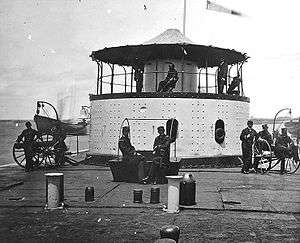USS Catskill (1862)
.jpg) USS Catskill in 1898 while on coastal defense duty during the Spanish–American War. | |
| History | |
|---|---|
| Name: | USS Catskill |
| Builder: | Continental Iron Works |
| Laid down: | 1862 |
| Launched: | December 16, 1862 |
| Commissioned: | February 24, 1863 |
| Decommissioned: | September 22, 1898 |
| Renamed: |
|
| Fate: | sold, December 4, 1901 |
| General characteristics | |
| Class and type: | Passaic-class ironclad monitor |
| Displacement: | 1,335 long tons (1,356 t) |
| Length: | 200 ft (61 m) o/a |
| Beam: | 46 ft (14 m) |
| Draft: | 10 ft 6 in (3.20 m) |
| Installed power: | 320 ihp (240 kW) |
| Propulsion: |
|
| Speed: | 7 kn (8.1 mph; 13 km/h) |
| Complement: | 87 |
| Armament: | 1 × 15 in (380 mm) smoothbore gun, 1 × 11 in (280 mm) Dahlgren gun, 2 × 12-pounder Dahlgren deck howitzers (picket duty only) |
| Armor: |
|
| Notes: | Armor is iron. |
USS Catskill (1862) was a monitor built for the United States Navy during the American Civil War. She continued to serve the Navy after the war’s end until decommissioned in 1898 after the end of the Spanish–American War.
Construction
USS Catskill—a single-turreted Passaic-class monitor—was launched on December 16, 1862 by Continental Iron Works, Greenpoint, N.Y.; outfitted at New York Navy Yard; commissioned on February 24, 1863, Commander George Washington Rodgers in command; and reported to the South Atlantic Blockading Squadron.
Civil War operations

Assigned to the South Atlantic blockade
Catskill reported for duty at Port Royal, S.C. on March 5, 1863, and for the remainder of the war operated off Charleston, S.C.. Catskill was damaged by Confederate gunfire during the 7 April attack on Fort Sumter that demonstrated both the strengths of well-defended fortifications and the limitations of monitor-type ironclads. That began the lengthy series of operations against the strongly fortified and stoutly defended harbor.
From July–September 1863, Catskill repeatedly took part in attacks on the batteries and forts protecting Charleston from the sea. Rodgers was killed in action on 17 August, while directing the fire of his ship against Charleston's forts. The ship was hit by Confederate gunfire on several occasions, but skillful work by her crew—now under the command of Lieutenant Commander Edward Barrett—returned her to action without returning for repairs.
Catskill destroyed the grounded blockade runner Prince Albert off Fort Moultrie on August 9, 1864. When Charleston was evacuated on 18 February 1865, she boarded and took possession of the grounded blockade runner, Deer, and later in that day raised the flag over another grounded steamer, Celt.
Post–Civil War service
Relieved from duty, Catskill cleared Charleston on July 13, and sailed to the Philadelphia Navy Yard, where she was decommissioned on 26 July. Here she remained in ordinary until 1873. During that time, she was briefly renamed Goliath (June 15 – August 10, 1869). Repaired at New York during 1874 and 1875, Catskill joined the North Atlantic Squadron, with whom she cruised along the northeast coast from March 4, 1876 – November 5, 1877. From 1878 to 1895, Catskill was in ordinary at various anchorages in Virginia, and from 1895 to 1898 in ordinary at Philadelphia's League Island Navy Yard.
Spanish–American War service
Upon the outbreak of the Spanish–American War, Catskill was recommissioned for patrol duty in New England waters. This lasted from April 16 – September 22, 1898, after which Catskill returned to League Island until sold on 4 December 1901.
References
- This article contains text from the US Naval Historical Center.
- This article incorporates text from the public domain Dictionary of American Naval Fighting Ships. The entry can be found history.navy.mil here.
- Additional technical data from Gardiner, Robert (1979). Conway's All The World's Fighting Ships 1860–1905. Conway Maritime Press. p. 120. ISBN 0-85177-133-5.